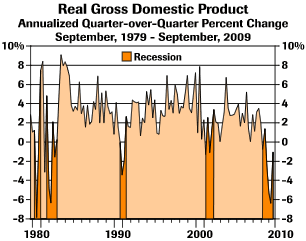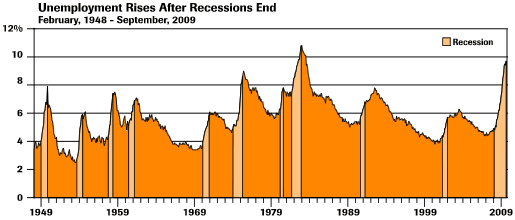2009 Q3 | Economic Growth Returns — Markets Respond
 The domestic economy most likely turned up in the third quarter of 2009, abating fears of a major economic depression. Seven of the ten leading indicators are now positively contributing to the Index of Leading Economic Indicators. The economic dislocations of 2007 and 2008 are receding. One of the leading indicators, the S&P 500 Index, delivered another very strong quarter, making it two consecutive double-digit percentage increases. The S&P rose 15.6%, the Dow was up 15.7% and the NASDAQ jumped 15.7%. Last quarter, these indexes increased 15.9%, 11.9% and 20.0%, respectively. These results are the best quarterly returns in a decade. Even after this tremendous run, the S&P 500 is still almost 15% below the level experienced when Lehman Brothers declared bankruptcy on September 15, 2008.
The domestic economy most likely turned up in the third quarter of 2009, abating fears of a major economic depression. Seven of the ten leading indicators are now positively contributing to the Index of Leading Economic Indicators. The economic dislocations of 2007 and 2008 are receding. One of the leading indicators, the S&P 500 Index, delivered another very strong quarter, making it two consecutive double-digit percentage increases. The S&P rose 15.6%, the Dow was up 15.7% and the NASDAQ jumped 15.7%. Last quarter, these indexes increased 15.9%, 11.9% and 20.0%, respectively. These results are the best quarterly returns in a decade. Even after this tremendous run, the S&P 500 is still almost 15% below the level experienced when Lehman Brothers declared bankruptcy on September 15, 2008.
Global financial markets also pulled back in concert with our market during last fall’s confrontation with financial calamity. Successful world-wide coordinated fiscal and monetary actions by numerous central banks avoided a replay of the financial crisis of the 1930’s. In 1931, the collapse of the Austrian bank Creditanstalt, and the subsequent failure of world bankers to rescue it, led directly to a trade collapse and a series of trade wars that vastly complicated the economic crisis of the 1930’s. With the United States’ rescue of American International Group, the world was saved from a far more serious economic challenge in 2008. This should give us confidence to begin a process of implementing regulatory changes that will strengthen the world’s economies and financial markets in the years ahead.
Did the world’s banking system get it right this time? Unfortunately, we will have to wait and see. The fact that the world’s financial system is still functioning suggests a great deal was done right. We should be encouraged that future world prosperity can be more closely coordinated than at any time since the end of World War II.
Adding to this positive environment is the realization that major economies around the world appear to be entering expansionary phases, which should be good news for sustaining growth into 2010. The new economic debate will be more about the magnitude of this recovery and increasingly less concern will be expressed about the possibility of a ”double-dip” recession. I have studied economic recoveries for years and fears of a double-dip seem to accompany every recovery. The only validation of such a fear occurred in the economic period between 1980 and 1982 (see chart).
 A primary reason our economy will avoid a double-dip is the low interest rate environment created by the very accommodative Federal Reserve policies implemented in 2007. These policies are having a positive impact on the economy. Investors looking for income, however, are struggling to find yield. Rates along the yield curve for Treasuries and municipal bonds are approaching historically low levels. Corporate bonds are the only area offering a modest amount of value, and even that appears to be diminishing. As the economy improves, however, rates should rise. Because of this, we remain patient and cautious with respect to new bond purchases and urge investors not to stretch for yield.
A primary reason our economy will avoid a double-dip is the low interest rate environment created by the very accommodative Federal Reserve policies implemented in 2007. These policies are having a positive impact on the economy. Investors looking for income, however, are struggling to find yield. Rates along the yield curve for Treasuries and municipal bonds are approaching historically low levels. Corporate bonds are the only area offering a modest amount of value, and even that appears to be diminishing. As the economy improves, however, rates should rise. Because of this, we remain patient and cautious with respect to new bond purchases and urge investors not to stretch for yield.
Low interest rates are also helping the housing market. Housing prices in most parts of the country have at least stabilized and demand for housing has improved in recent months. Inventories of unsold houses fell by three months, from a ten month supply to around seven. Although these numbers are still above optimal levels of four to five months, the trend is now favorable. In addition to low mortgage rates, the popular government program giving first-time home buyers an $8,000 tax credit is helping the housing market. The tax credit will expire at the end of November. Although it will drop some as a result, hopefully demand for housing will remain steady without this added stimulus.
– – – – – – – – – – – – – – – – – – – – – – – – – – – – – – – – – – – – – – – – – –
The government’s innovative automotive incentive
program, nicknamed “Cash for Clunkers,”
appears to have worked.
– – – – – – – – – – – – – – – – – – – – – – – – – – – – – – – – – – – – – – – – – –
Finally, the consumer must return to the stores for the economy to get on truly firm footing. Retail sales continue to decline on a year-over-year basis. Consumer confidence, which is well off of its lowest level, is still below the prior historic lows. The consumer will not spend until the job picture improves. Unlike the monthly unemployment figure, which is a lagging indicator partly because it is a month behind, the initial claims number gives us a look into the current job market. There is some modest good news on that front as weekly first-time unemployment claims, another important leading indicator, are improving. As employment improves, so too should consumer spending.
The government’s innovative automotive incentive program, nicknamed ”Cash for Clunkers,” appears to have worked. Annualized sales levels of vehicles jumped from slightly under 10 million units during the second quarter to over 13 million units at the peak of the program. Adding to automotive demand has been the successful launch of several new products by Ford and General Motors. The new challenge facing the automobile industry will be to right-size currently low inventory levels, which will require sharp increases in output. This is a welcome challenge coming from the near depression conditions that prevailed in the first half of 2009.
All of these developments will, at last, contribute to an improvement in the employment levels in this country. Unemployment levels continue to move higher but that is a very common phenomenon (see chart). Admittedly, 9.7% is a significant level for unemployment. Only once since WWII have we experienced a higher unemployment level. As you can see from the chart, in almost every case, unemployment increases after the recession ends. We believe an end to the economic downturn is at hand. By mid-2010, improved employment trends should be evident and the unemployment rate could fall to the 7.5 – 8% range.

The last twelve months have been one of the most challenging periods in the financial markets since the 1920s. In the subsequent depression, the Roosevelt Administration implemented many regulations that stabilized our financial system and led to a period of unprecedented prosperity for the U. S. and the world. In brief, we learn from our mistakes.
To date, Congress and the Executive Branch have failed to undertake a serious review of the business practices that led to the chaos in our financial markets nearly a year ago. Unrestrained short selling, naked short selling, leverage, flash trading, hedge funds and Ponzi schemes all abound. They are unchecked by any new regulatory recommendations by the government or the private sector. Hiding behind budgetary restraints, many of our government regulatory agencies have shrunk from their duties and have contributed to the volatility that impacted our markets.
– – – – – – – – – – – – – – – – – – – – – – – – – – – – – – – – – – – – – – – – – –
The last twelve months have been one of the most challenging periods in the history of the financial markets since the 1920s.
– – – – – – – – – – – – – – – – – – – – – – – – – – – – – – – – – – – – – – – – – –
The result: investors will demand greater risk premiums for financial assets which could contribute to lower price-earnings ratios and higher interest rates than otherwise would have occurred. If the cost of capital to corporations is adversely impacted, the fragile nature of this economic recovery could be compromised. The time to undertake a financial pathology report of the events leading up to the crisis is now. Whether it is the established regulatory agencies, such as the Federal Deposit Insurance Corporation (FDIC) and the Securities and Exchange Commission (SEC), or some new organization, now is the time to shore up investor protections through more effective government regulations.
In closing, patience has paid off- we have had a great run these past several months. In the investment business, perseverance can be a challenge. Fear and greed inspire investors to make some irrational choices. This year exemplified that timing the market is an extremely difficult proposition. From the depths of the market lows in March, to a massive 50% rally through September, we have seen the extremes in market fluctuations. Our clients have been remarkably unwavering in their commitments to their investment objectives. And that we are thankful for.
—Jim Hardesty



